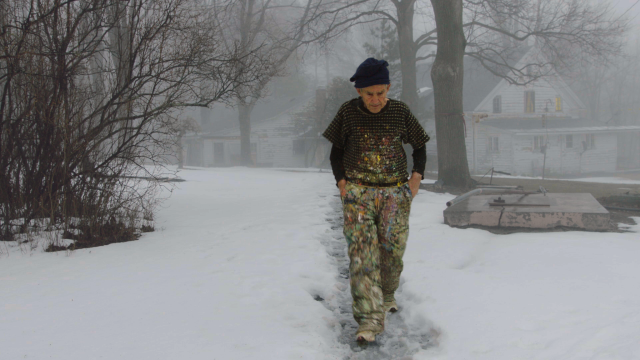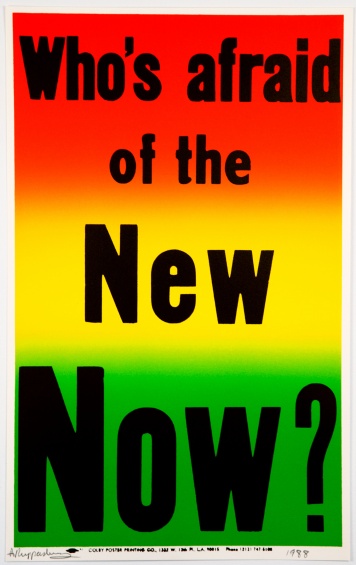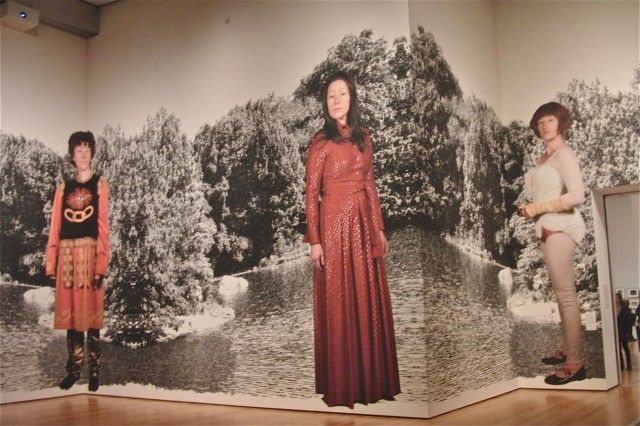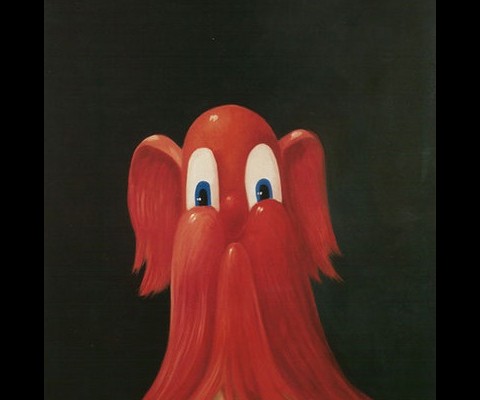
George Condo, “Red Antipodular Portrait,” oil on canvas, 1996
New Museum of Contemporary Art
235 Bowery at Prince St.
Festival of Ideas for the New City: May 4-8
“George Condo: Mental States” through May 8
“Lynda Benglis”: through June 19
Wednesday – Sunday, $12 (Thursdays free 7:00 – 9:00)
212-219-1222
www.newmuseum.org
www.festivalofideasnyc.com
If you’ve been experiencing difficulty with your mental state these days — and who hasn’t — you can find relief at the New Museum, where “George Condo: Mental States” continues through Sunday. The engaging work of the influential East Village painter is spread across two floors, from the “fake old masters” of his 1980s heyday to lush, large-scale acrylic, charcoal, and pastel on linen pieces that dazzle the mind. Condo displays his expert skill in mimicking, mocking, melding, and honoring myriad styles, whether it’s creating creepy, comic-book-like characters in his Pathos (“The Janitor’s Wife”) and Mania (“Nude Homeless Drinker”) series or a collection of stirring Abstractions (“Nothing Is Important,” “Dancing to Miles”). But the really head-spinning part of the show is on the fourth floor, where dozens of portraits are arranged on one wall in a dizzying array of colors and styles, one after another, serving as a kind of art history course all its own, part Name That Influence, part, well, whatever is going on inside Condo’s brain at the time. If you stare at it long enough, it is sure to blow your mind.
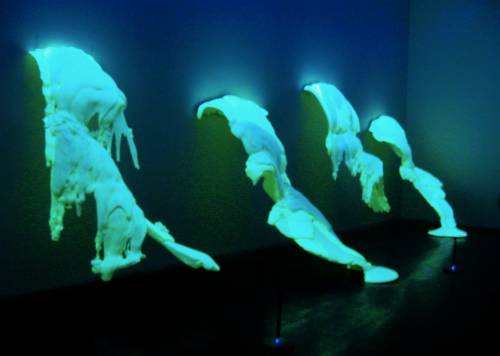
Lynda Benglis, “Phantom,” detail, polyurethane foam with phosphorescent pigments, five elements, 1971 (photo by twi-ny/mdr)
Lynda Benglis takes visitors on a different kind of head trip with an exciting retrospective — surprisingly, her first in New York — on the New Museum’s second floor and in the lobby gallery, comprising some fifty works, including photography, video, sculpture, and various ephemera. Be careful where you walk, because many of Benglis’s abstract creations, composed of such materials as wax, wood, glitter, latex, paper, cotton bunting, wire, plaster, polyurethane foam, aluminum, lead, and bronze, jut out from the walls and lie across the floor, forming a delicate maze closely watched by guards who will definitely let you know when you get too close. Be on the lookout for “Untitled (VW),” a pigmented polyurethane foam piece that is cut away, giving an inside look at Benglis’s creative process. There are a number of her delightful “fallen paintings,” but the highlight of the show, which runs through June 19, is 1971’s “Phantom,” which consists of five large polyurethane foam abstract works with phosphorescent pigments that glow in the dark when the lights go down.

“After Hours: Murals on the Bowery” is part of Festival of Ideas for the New City
The New Museum is also one of the hosts of this week’s Festival of Ideas for the New City, which begins today with a series of lectures and panel discussions at NYU and the Cooper Union, with such participants as Rem Koolhaas, Vito Acconci, Elizabeth Diller, David Byrne, Kurt Andersen, Jonathan Bowles, Suketu Mehta, Jonathan F. P. Rose, Sergio Fajardo, Antanas Mockus, and Pedro Reyes examining such topics as “The Heterogeneous City,” “The Networked City,” “The Sustainable City,” “Built Environment,” and “Downtown NYC Policy Issues.” On Saturday and Sunday, there will be special projects at locations all over the Lower East Side and the East Village, featuring live performances, film screenings, workshops and demonstrations, site-specific installations, and more. At the New Museum, OMA/Rem Koolhaas’s “Cronocaos” opens May 7, examining the past, present, and future of preservation, construction, and urbanism, while Maya Lin reimagines the Hudson River system in “Pin River-Hudson.” The New Museum is a central part of Saturday’s StreetFest: The institution has collaborated with the Rockwell Group to create “Imagination Playground,” a special area for family activities; teenagers from City-as-School will serve as roving reporters covering the festival; “Let Us Make Cake” will feature video interactions with scale models of the New Museum by such artists as Acconci Studio, Mia Pearlman, Dustin Yellin, Jon Kessler, and Marilyn Minter, projected onto the building’s facade; and, in conjunction with the Art Production Fund, “After Hours: Murals on the Bowery” will be unveiled, in which artists such as Matthew Brannon, Ellen Gallagher, Amy Granat, Mary Heilmann, Barry McGee, Sterling Ruby, Glenn Ligon, Rirkrit Tiravanija, and Lawrence Weiner have created murals on roll-down security shutters along Bowery.
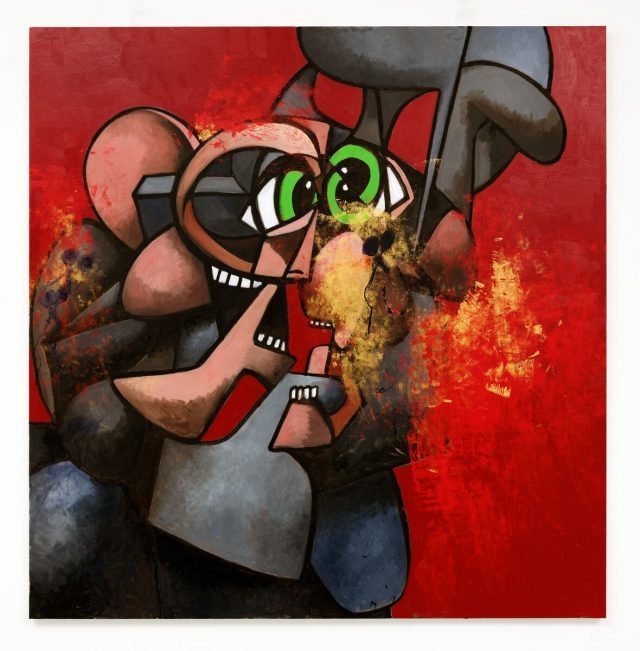
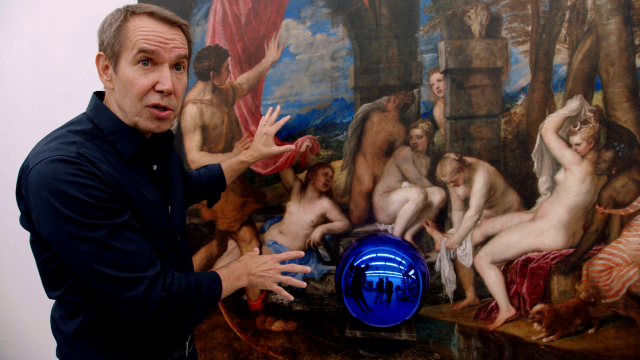
 On October 4, a framed painting titled “Girl with Balloon” by British street artist and provocateur Banksy began shredding itself upon being sold for $1.4 million at a Sotheby’s auction, shocking and delighting the art world. Was Banksy, whose very name evokes cold, hard cash, making a sly comment on the art market, on auctions, on the intrinsic value of a work of art? In the immediate aftermath, there was general confusion about just what the buyer had purchased and whether she had to keep it at all. In many ways that stunt exemplifies what Nathaniel Kahn’s highly artistic documentary, The Price of Everything, is all about. Kahn, who was nominated for Oscars for his 2003 film, My Architect: A Son’s Journey, which explored the legacy of his father, Louis Kahn, and his 2006 short, Two Hands, about pianist Leon Fleisher, this time trains his camera on the volatile global art market. “Art and money have always gone hand in hand,” superstar auctioneer Simon de Pury says. “It’s very important for good art to be expensive. You only protect things that are valuable. If something has no financial value, people don’t care. They will not give it the necessary protection. The only way to make sure that cultural artifacts survive is for them to have a commercial value.”
On October 4, a framed painting titled “Girl with Balloon” by British street artist and provocateur Banksy began shredding itself upon being sold for $1.4 million at a Sotheby’s auction, shocking and delighting the art world. Was Banksy, whose very name evokes cold, hard cash, making a sly comment on the art market, on auctions, on the intrinsic value of a work of art? In the immediate aftermath, there was general confusion about just what the buyer had purchased and whether she had to keep it at all. In many ways that stunt exemplifies what Nathaniel Kahn’s highly artistic documentary, The Price of Everything, is all about. Kahn, who was nominated for Oscars for his 2003 film, My Architect: A Son’s Journey, which explored the legacy of his father, Louis Kahn, and his 2006 short, Two Hands, about pianist Leon Fleisher, this time trains his camera on the volatile global art market. “Art and money have always gone hand in hand,” superstar auctioneer Simon de Pury says. “It’s very important for good art to be expensive. You only protect things that are valuable. If something has no financial value, people don’t care. They will not give it the necessary protection. The only way to make sure that cultural artifacts survive is for them to have a commercial value.”